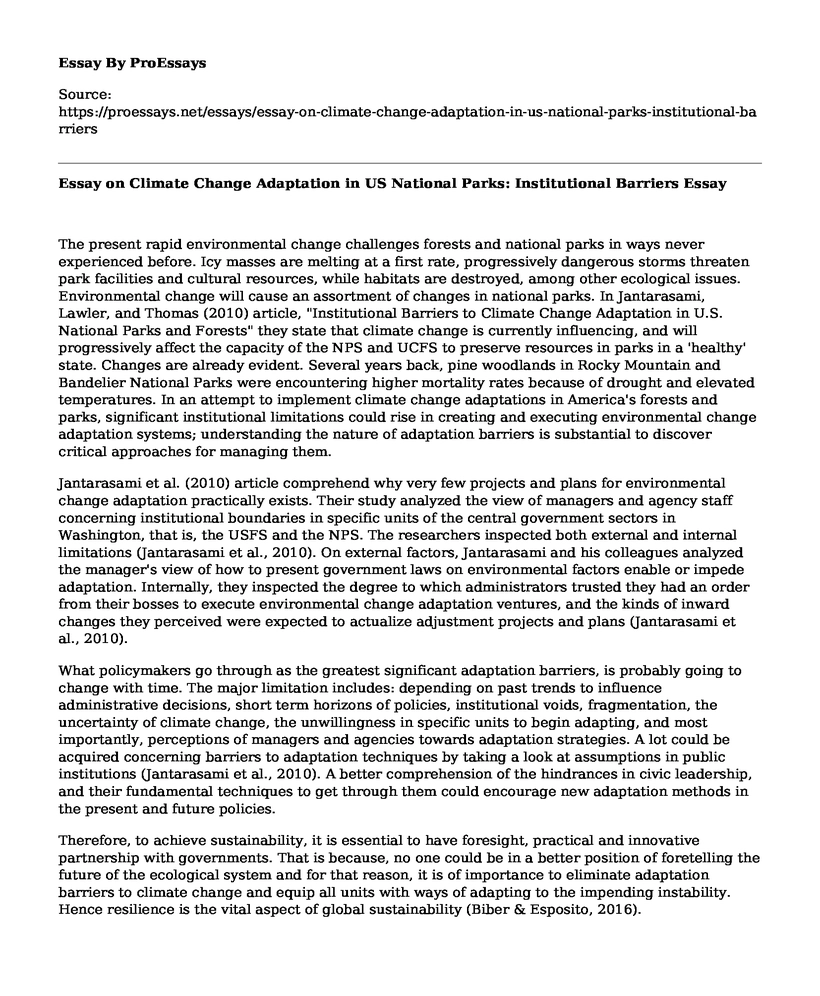The present rapid environmental change challenges forests and national parks in ways never experienced before. Icy masses are melting at a first rate, progressively dangerous storms threaten park facilities and cultural resources, while habitats are destroyed, among other ecological issues. Environmental change will cause an assortment of changes in national parks. In Jantarasami, Lawler, and Thomas (2010) article, "Institutional Barriers to Climate Change Adaptation in U.S. National Parks and Forests" they state that climate change is currently influencing, and will progressively affect the capacity of the NPS and UCFS to preserve resources in parks in a 'healthy' state. Changes are already evident. Several years back, pine woodlands in Rocky Mountain and Bandelier National Parks were encountering higher mortality rates because of drought and elevated temperatures. In an attempt to implement climate change adaptations in America's forests and parks, significant institutional limitations could rise in creating and executing environmental change adaptation systems; understanding the nature of adaptation barriers is substantial to discover critical approaches for managing them.
Jantarasami et al. (2010) article comprehend why very few projects and plans for environmental change adaptation practically exists. Their study analyzed the view of managers and agency staff concerning institutional boundaries in specific units of the central government sectors in Washington, that is, the USFS and the NPS. The researchers inspected both external and internal limitations (Jantarasami et al., 2010). On external factors, Jantarasami and his colleagues analyzed the manager's view of how to present government laws on environmental factors enable or impede adaptation. Internally, they inspected the degree to which administrators trusted they had an order from their bosses to execute environmental change adaptation ventures, and the kinds of inward changes they perceived were expected to actualize adjustment projects and plans (Jantarasami et al., 2010).
What policymakers go through as the greatest significant adaptation barriers, is probably going to change with time. The major limitation includes: depending on past trends to influence administrative decisions, short term horizons of policies, institutional voids, fragmentation, the uncertainty of climate change, the unwillingness in specific units to begin adapting, and most importantly, perceptions of managers and agencies towards adaptation strategies. A lot could be acquired concerning barriers to adaptation techniques by taking a look at assumptions in public institutions (Jantarasami et al., 2010). A better comprehension of the hindrances in civic leadership, and their fundamental techniques to get through them could encourage new adaptation methods in the present and future policies.
Therefore, to achieve sustainability, it is essential to have foresight, practical and innovative partnership with governments. That is because, no one could be in a better position of foretelling the future of the ecological system and for that reason, it is of importance to eliminate adaptation barriers to climate change and equip all units with ways of adapting to the impending instability. Hence resilience is the vital aspect of global sustainability (Biber & Esposito, 2016).
Conclusion
In conclusion, future research ought to go past posing the questions of "which" adaptation barriers exist and start asking "why" and "how" barriers arise. Since the determination of suitable adoption systems relies upon the anticipated local ecological conditions and climate impacts, there could be no single specific measure concerning the kind of adaptation techniques which needs implementations. Unit-level executives are better situated to settle on those choices depending on their perception of the local milieu. Government institutions also ought to give the crucial resources, that is, information, labor, and funding, to enable unit-level decision-making.
References
Biber, E., & Esposito, E. L. (2016). The National Park Service Organic Act and Climate Change. Natural Resources Journal, 56(1), 193-245. Retrieved from: https://scholarship.law.berkeley.edu/cgi/viewcontent.cgi?article=3584&context=facpubs
Jantarasami, L., Lawler, J., & Thomas, C. (2010). Institutional Barriers to Climate Change Adaptation in U.S. National Parks and Forests. Ecology and Society 15(4): 33. Retrieved from: http://www.ecologyandsociety.org/vol15/iss4/art33/
Cite this page
Essay on Climate Change Adaptation in US National Parks: Institutional Barriers. (2023, Jan 02). Retrieved from https://proessays.net/essays/essay-on-climate-change-adaptation-in-us-national-parks-institutional-barriers
If you are the original author of this essay and no longer wish to have it published on the ProEssays website, please click below to request its removal:
- Paper Example on NYS Ethics Enforcement
- China's Move to End the Presidential Term Limit Could Revive Historical Dictatorship
- Weather/Climate in South Africa - Essay Sample
- Research Paper on Global Warming and its Impact on our Health
- Paper Example on High Healthcare Costs: An Imperfect US Health Care Market
- Weather and Climate: Impact on Aviation Industry - Essay Sample
- Paper Example on Protecting Civil Liberties: A Crucial Role in American Society







